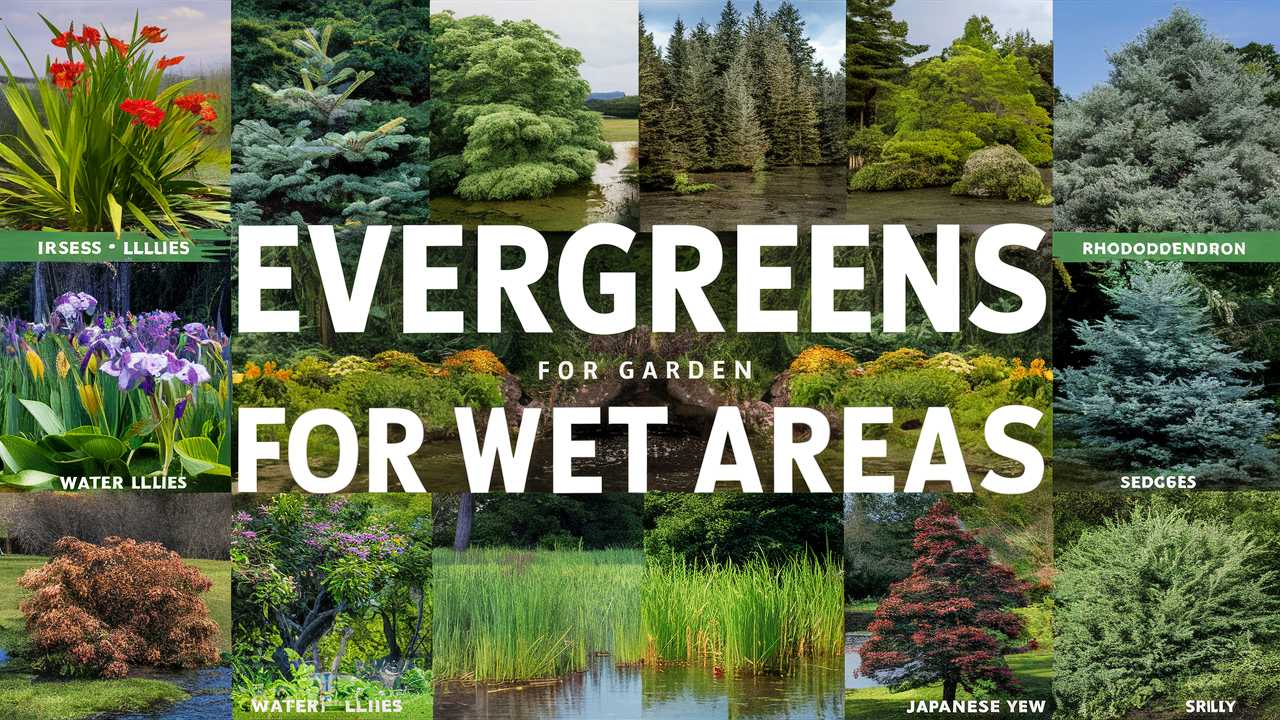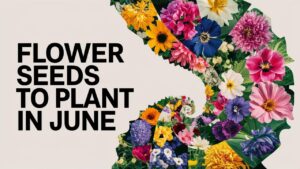Gardening in wet areas can present a unique set of challenges, especially when it comes to selecting appropriate plants. Soil saturation, standing water, and fluctuating moisture levels require plants that can thrive in these conditions. Luckily, there is an array of evergreen trees and shrubs that not only tolerate wet conditions but can also add beauty and structure to your landscape.
Below, we will explore some of the best evergreens for wet areas, providing an in-depth look at each plant and its advantages for waterlogged landscapes.
Bald Cypress (Taxodium distichum)

The Bald Cypress is a classic choice for wet areas, especially in the southeastern United States. This deciduous conifer has a unique ability to thrive in swampy soils, making it a resilient option for gardeners dealing with periodic flooding or standing water. The Bald Cypress can reach heights of up to 120 feet and showcases feathery, soft green foliage that turns brilliant orange or gold in the fall.
One of the striking features of this tree is its “knees.” These growths emerge from the roots and can be seen above the waterline, adding character to the landscape. Beyond its aesthetic appeal, the Bald Cypress provides critical habitat for birds, small mammals, and various aquatic life. Its ability to sequester carbon and filter pollutants also makes it an excellent choice for environmentally mindful gardeners.
Arborvitae (Thuja occidentalis)
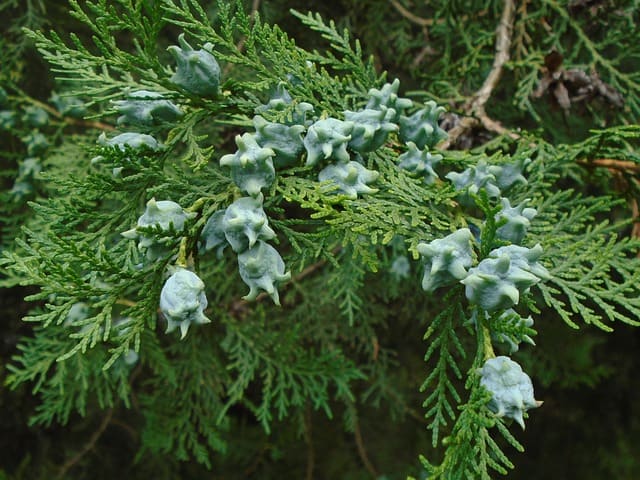
Arborvitae is another versatile evergreen, known for its tall, slender form and dense foliage. While it generally prefers well-drained soils, certain varieties adapt well to wetter conditions, especially if the water doesn’t stay saturated for extended periods. Arborvitae is often used as a privacy screen or windbreak, providing both functionality and beauty.
The foliage of Arborvitae is typically bright green and can take on a golden hue in the winter, offering year-round interest. One of the most notable varieties, the ‘Emerald Green’, grows to about 15 feet tall and maintains a narrow profile, making it ideal for smaller spaces. These trees are also easy to shape through pruning, allowing gardeners to create a tailored look in rain-prone areas.
American Cranberry (Vaccinium macrocarpon)
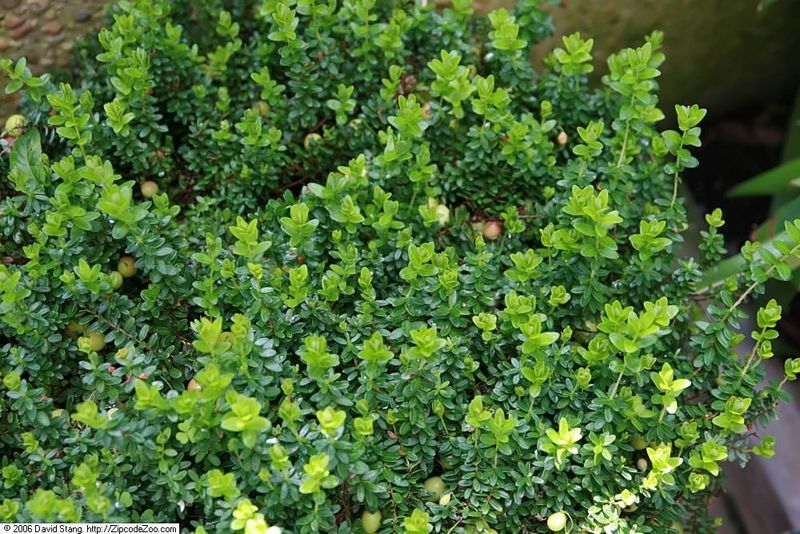
While often recognized for its fruit rather than its evergreen qualities, the American Cranberry is indeed a hardy perennial that can thrive in moist areas. This shrub is a staple in wetland habitats and is renowned for its culinary value, making it a practical choice for garden enthusiasts who appreciate fresh, home-grown produce.
The American Cranberry produces small white flowers that bloom in the spring, and its glossy, dark-green leaves remain vibrant throughout the seasons. Additionally, this plant can enhance biodiversity in your garden by attracting birds and pollinators. With its attractive fall foliage and edible berries, it’s a plant that beautifully combines function and aesthetic appeal.
Inkberry (Ilex glabra)
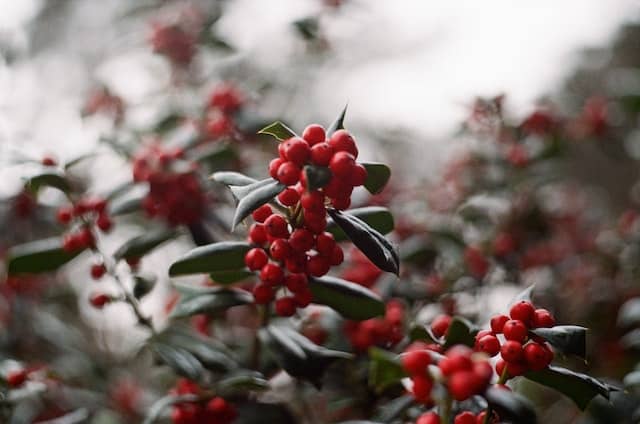
Inkberry is an excellent evergreen shrub that tolerates wet soils and is native to the eastern United States. This holly species prefers acidic soils and is often found in swampy areas, making it perfect for wet landscaping. It typically grows between 4 to 6 feet tall and has glossy, dark green leaves that provide a lush backdrop for other plants.
In terms of wildlife, Inkberry berries are a favorite among birds, which adds an extra layer of environmental benefit to your landscape. Furthermore, Inkberry’s dense growth habit makes it suitable for hedging or as a natural privacy screen. It can also handle pruning well, allowing for creative landscaping options.
Hardy Anise (Illicium parviflorum)
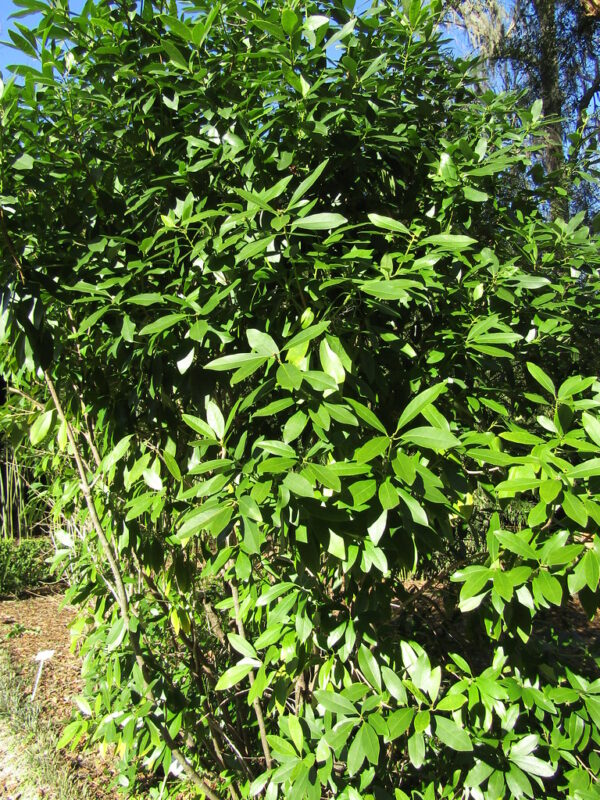
The Hardy Anise is a lesser-known yet remarkable evergreen for wet areas. Thriving in moist, shaded conditions, it produces fragrant green leaves that release a sweet aroma when crushed, leading to its common name. The plant can grow up to 8 feet tall and spreads about 6 feet wide, creating a lovely bushy look that’s appealing throughout the year.
This shrub produces delicate yellow star-shaped flowers in the spring, providing a visual treat amidst the rich green foliage. Hardy Anise is particularly attractive to pollinators, further enhancing the ecosystem of your garden. Its adaptability to varying moisture levels makes it a reliable choice for gardeners in humid climates.
Chinese Swamp Cypress (Glyptostrobus pensilis)

The Chinese Swamp Cypress is a rare and beautiful addition to wetland areas. Often confused with the Bald Cypress, it features soft, feathery foliage that turns vivid shades of red and gold in the fall. This deciduous conifer can grow up to 100 feet tall, forming a broad, rounded crown that provides ample shade.
Chinese Swamp Cypress is beneficial for flood control, as its extensive root system absorbs excess water and stabilizes soils. This plant also provides critical habitat for wildlife, particularly birds and aquatic organisms. Incorporating this majestic tree into your landscape can enhance both its beauty and ecological function.
Wax Myrtle (Morella cerifera)
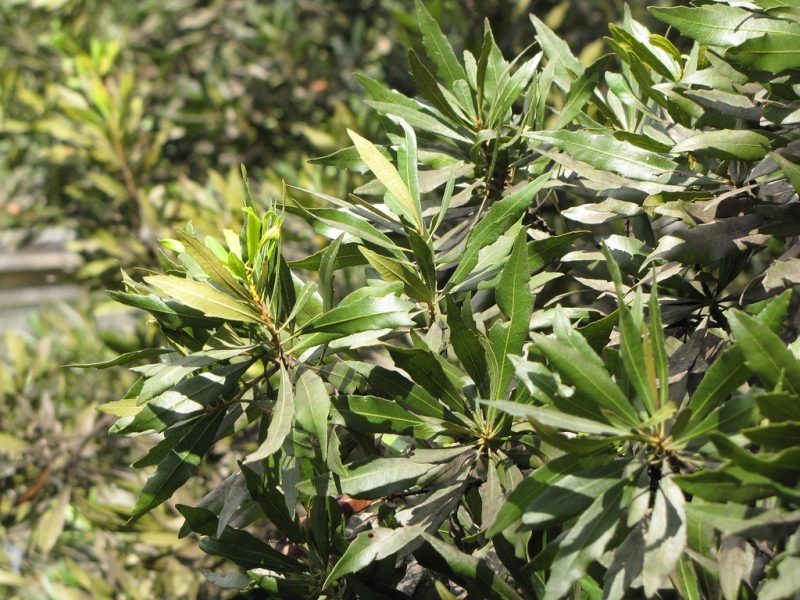
Wax Myrtle is a tough, adaptable evergreen shrub that thrives in wet areas. With an aromatic fragrance and vibrant green foliage, it’s a popular choice for coastal gardens, swamps, and wetlands. This shrub can reach heights of 10 to 15 feet and has a dense growth habit, making it perfect for screening and hedging.
The berries of the Wax Myrtle provide food for many bird species, while the foliage offers shelter. Additionally, this plant is known for its ability to absorb excess moisture, making it a natural choice for managing drainage issues. Its resilience and salt tolerance make Wax Myrtle an excellent selection for regions prone to coastal conditions.
Southern Magnolia (Magnolia grandiflora)
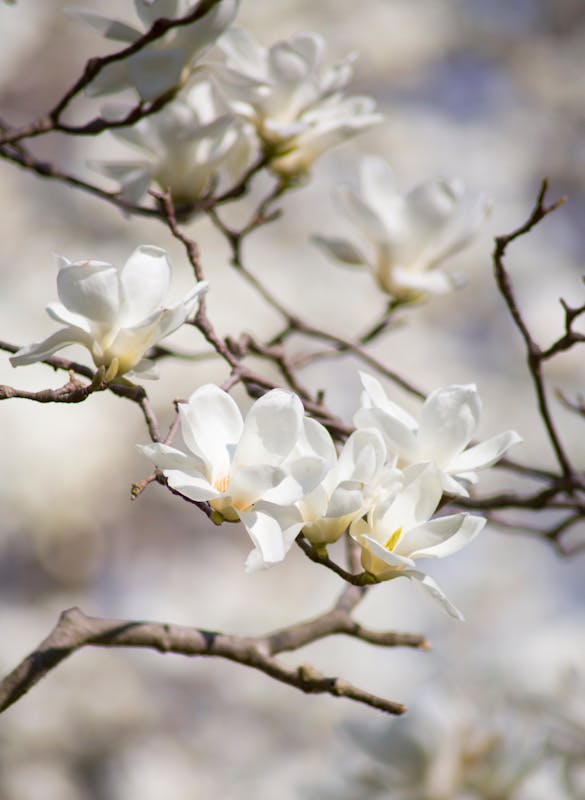
The Southern Magnolia is a classic southern evergreen that can tolerate wet conditions and is well-suited for a variety of landscapes. Boasting magnificent large, glossy leaves and stunning white flowers, this tree can grow up to 80 feet tall, making it a grand focal point in any garden.
Southern Magnolias can often be found growing near water bodies in their native habitat, illustrating their adaptability to wet soils. The tree’s flowers bloom in late spring and early summer, releasing a delightful fragrance that attracts pollinators. Besides its aesthetic appeal, the Southern Magnolia provides dappled shade, making it a wonderful choice for creating comfortable outdoor spaces.
American Holly (Ilex opaca)
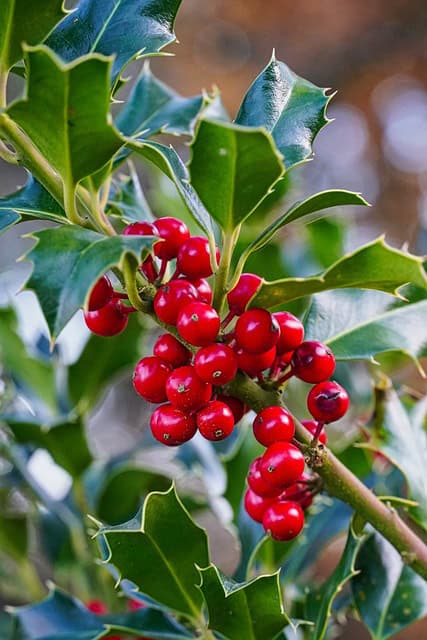
American Holly is a traditional evergreen that can thrive in various soil conditions, including wet areas. Known for its glossy, spiny leaves and bright red berries, this tree not only serves as an attractive landscape specimen but also provides essential habitats for birds and wildlife.
Typically growing between 15 and 30 feet, American Holly is also a valuable choice for those looking to create festive holiday displays in their gardens. The berries are edible for birds, although humans may want to avoid consumption. Given its versatility, this tree adapts well to multiple garden styles—from formal hedges to natural woodland environments.
Princess Flower (Tibouchina urvilleana)
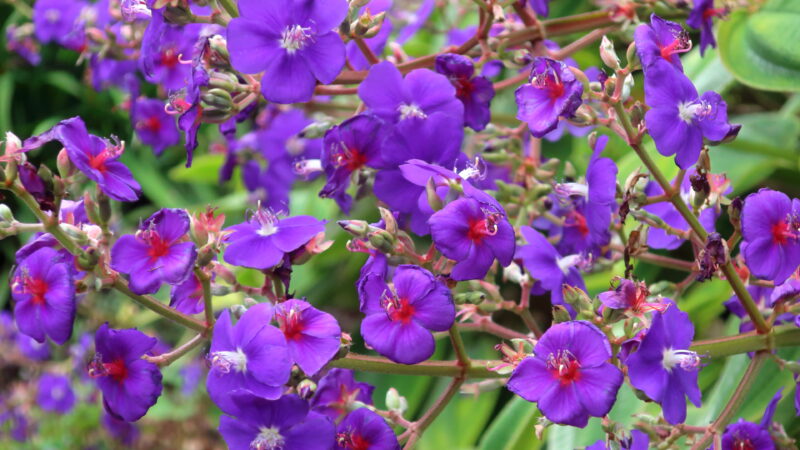
The Princess Flower is a somewhat unique addition to the list of evergreens for wet areas. This tropical flowering tree can add a vibrant splash of color to damp environments with its striking purple blooms. While more commonly found in milder climates, it can still thrive in certain wetland conditions if properly cared for.
Reaching heights of up to 10 feet, the Princess Flower also offers attractive green foliage that can lend structure to a garden. This plant is particularly appreciated for its stunning flowers, which attract butterflies and other pollinators. For a gardener looking to make a bold statement, the Princess Flower can be an exceptional choice for enlivening waterlogged landscapes.
Florida Anise (Illicium floridanum)
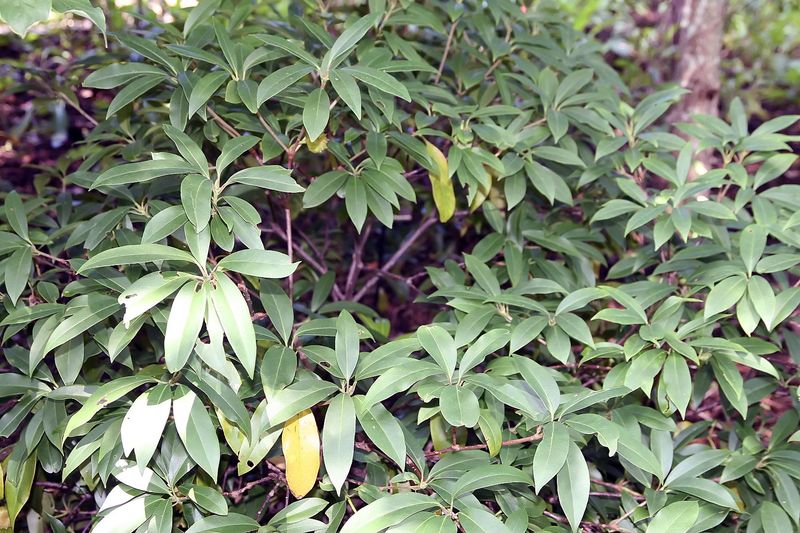
Florida Anise is a wonderful evergreen shrub that thrives in wet, shady conditions and adds an understated elegance to any garden. Known for its aromatic leaves that emit a pleasant, licorice-like fragrance, this shrub is both visually appealing and practically useful.
Typically growing between 4 to 8 feet tall, Florida Anise showcases beautiful star-shaped flowers that bloom in spring, offering a pop of color—particularly valued in shaded areas. This plant supports various wildlife, including pollinators and birds, contributing positively to biodiversity. Its ability to thrive in less-than-ideal soil conditions makes it a worthy consideration for wet area landscaping.
Shining Fetterbush (Lyonia lucida)

Shining Fetterbush is an evergreen shrub native to fluvial areas of the southeastern United States. This plant is well-adapted to moist, acidic soil and features glossy, evergreen leaves that maintain a vibrant appearance throughout the year.
In the spring, Shining Fetterbush produces attractive white to pale pink flowers that elevate its ornamental value and are particularly appealing to pollinators. As a wetland shrub, it’s invaluable for stabilizing soil and preventing erosion, making it a practical addition to any wet landscape. Its resilience hence provides a sustainable solution alongside aesthetic benefits.
Florida Leucothoe (Agarista populifolia)
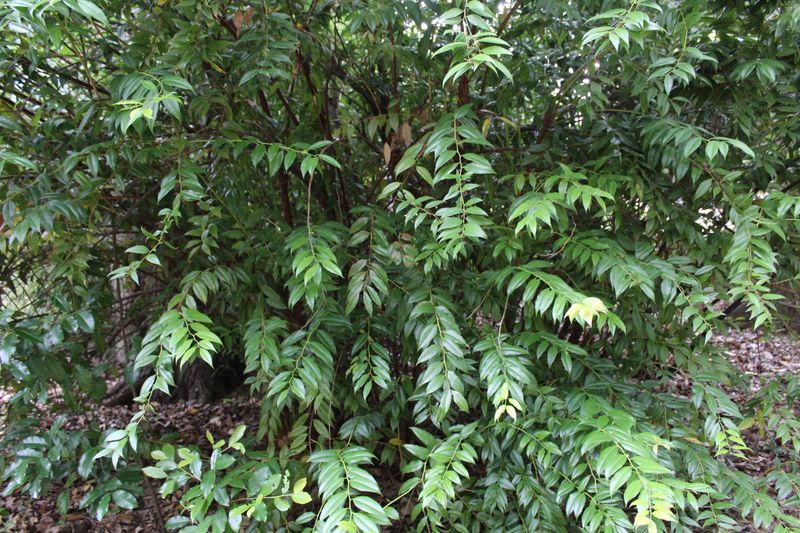
The Florida Leucothoe is a lovely evergreen shrub that thrives in shady, moist conditions. This plant grows about 3 to 6 feet tall and spreads elegantly across the landscape. Its glossy dark green leaves present a charming backdrop, especially when adorned with delicate white flowers that bloom in the spring.
This shrub is particularly well-suited for southern gardens, adding beauty and texture to shady areas near water bodies. The flowers help attract hummingbirds and bees, contributing to a rich ecosystem. Florida Leucothoe’s adaptability to wet soils coupled with its ornamental features makes it a fantastic option for gardeners in damp locales.
Leatherwood (Cyrilla racemiflora)
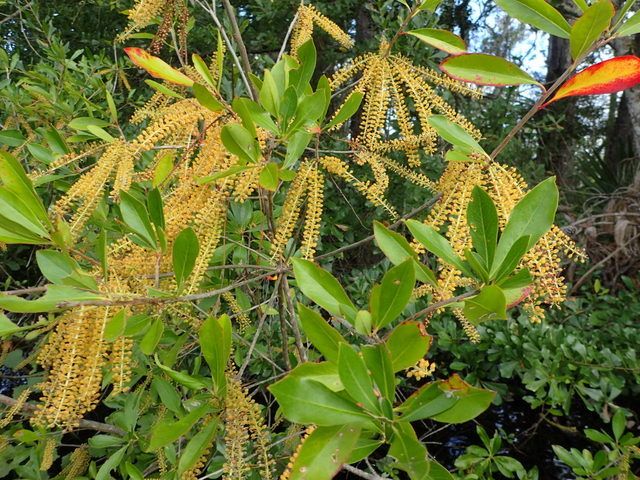
Leatherwood is a distinctive evergreen shrub that thrives in swampy areas. Found abundantly in the southeastern U.S., it can reach heights of up to 20 feet and has leathery leaves that offer a unique visual texture.
This plant produces delicate, fragrant white flowers in late spring, attracting butterflies and other pollinators. The Leatherwood’s ability to establish roots in wet conditions not only makes it a resilient option but also helps prevent soil erosion in waterlogged areas. Its beauty and ecological benefits make Leatherwood an excellent addition to any moisture-loving garden.
Japanese Fatsia (Fatsia japonica)
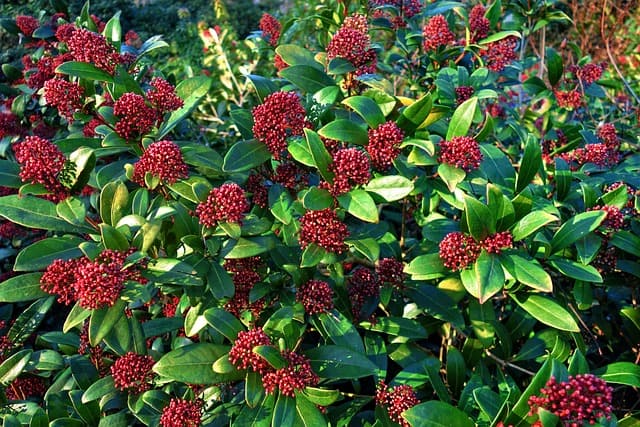
Japanese Fatsia is an attractive evergreen that can thrive in shady, moist areas, making it perfect for wet landscapes. With its leathery, palmate leaves, this shrub adds a tropical feel to gardens and typically grows to about 6 to 10 feet tall.
One of the appealing features of Japanese Fatsia is its ability to survive in various light conditions, from full shade to partial sun. During fall, it produces small white flowers that can attract bees and other beneficial insects. This adaptability to wet soils and versatility in growing conditions positions the Japanese Fatsia as an excellent specimen for diverse landscapes.
Winterberry (Ilex verticillata)

Winterberry is a deciduous holly that excels in wet, acidic soils. Although technically not an evergreen, it deserves mention for its winter interest and suitability for moist environments. Growing between 3 to 10 feet tall, Winterberry features striking red berries that persist throughout the frigid months, providing essential food for birds in winter.
During the growing season, the shrub displays glossy green leaves that exhibit stunning color changes in the fall. The female plants produce the bright berries, which can be a notable visual focus in winter landscapes. Hence, incorporating Winterberry into your wet area gardens can enhance not only the aesthetic appeal but also offer sustenance for wildlife during colder months.
Coastal Leucothoe (Leucothoe axillari)
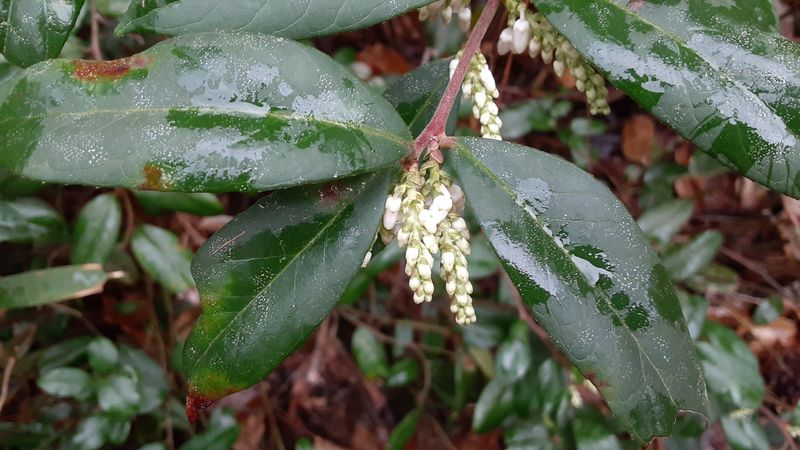
Coastal Leucothoe is a versatile evergreen that thrives in wet, acidic soils, making it a perfect addition to landscapes with ongoing moisture. This plant usually grows between 2 to 4 feet tall and features arching branches adorned with lush, glossy foliage.
In the spring, Coastal Leucothoe produces small, tubular white flowers that dangle from the branches, offering a charming display and attracting pollinators. Its ability to thrive in partial to full shade enhances its utility, making it ideal for naturalistic gardens or shaded landscapes near water. The Coastal Leucothoe enriches gardens, transforming damp areas into inviting retreats.
Devilwood (Osmanthus americanus)
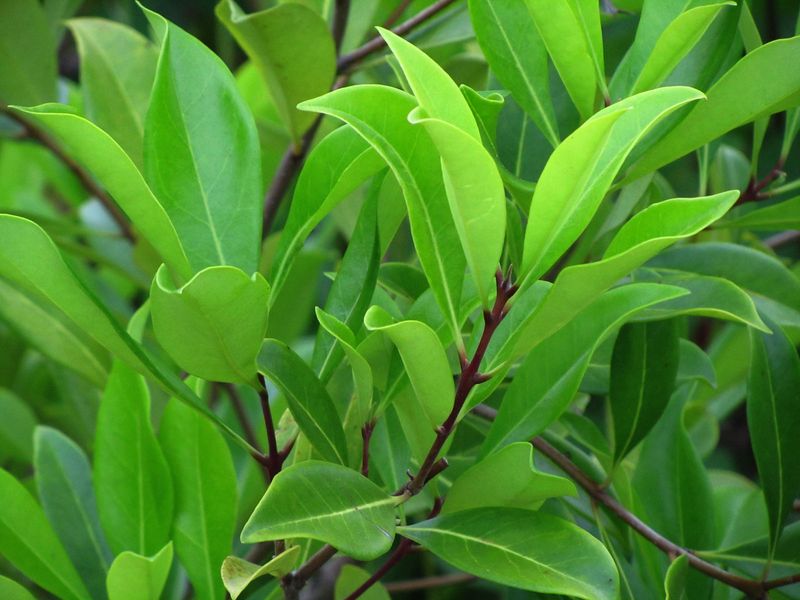
Devilwood is a unique evergreen shrub that’s perfect for wet areas. Known for its dense growth habit, this shrub can reach up to 10 feet tall and offers attractive, glossy leaves throughout the year. It is particularly valued for its fragrant white flowers that bloom in the spring, enticing not only gardeners but also a variety of pollinators.
This hardy shrub adapts well to various soil types, but it flourishes in moist conditions, making it an excellent choice for a landscape that experiences wet soils. It adds texture and structure to landscapes, while its fragrant blooms enhance the sensory experience of any garden. Devilwood’s ornamental characteristics paired with its hardiness make it a fabulous addition to wet areas.
Dwarf Palmetto (Sabal minor)
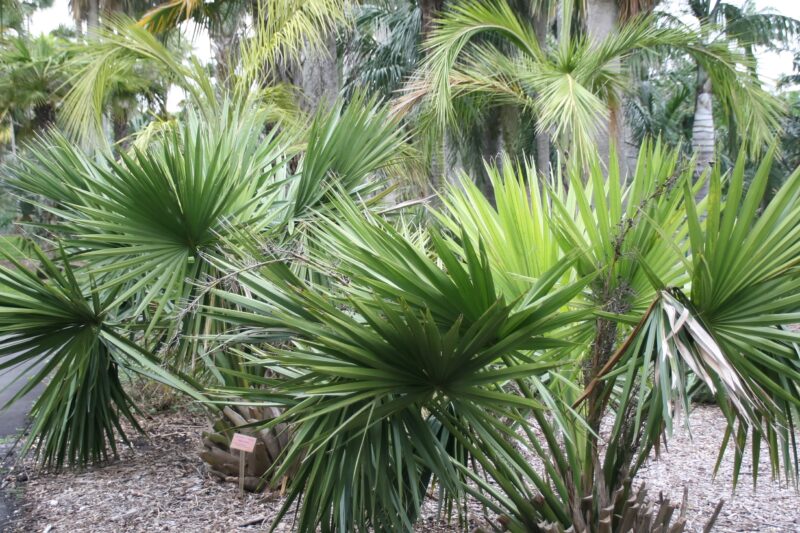
Dwarf Palmetto is a charming evergreen that thrives in wet, swampy conditions, making it ideal for boggy garden spaces. Typically growing between 3 to 6 feet tall, this palm adds a unique tropical flair to landscapes with its fan-shaped leaves and distinct trunk.
Dwarf Palmetto’s ability to withstand heavy moisture and humidity makes it particularly attractive for southern gardens and coastal areas. This plant can form colonies through underground rhizomes, creating a lush, tropical feel in your garden. Its hardiness and adaptability to wet conditions ensure that it remains a favorite among gardeners looking for unique evergreens for damp areas.


